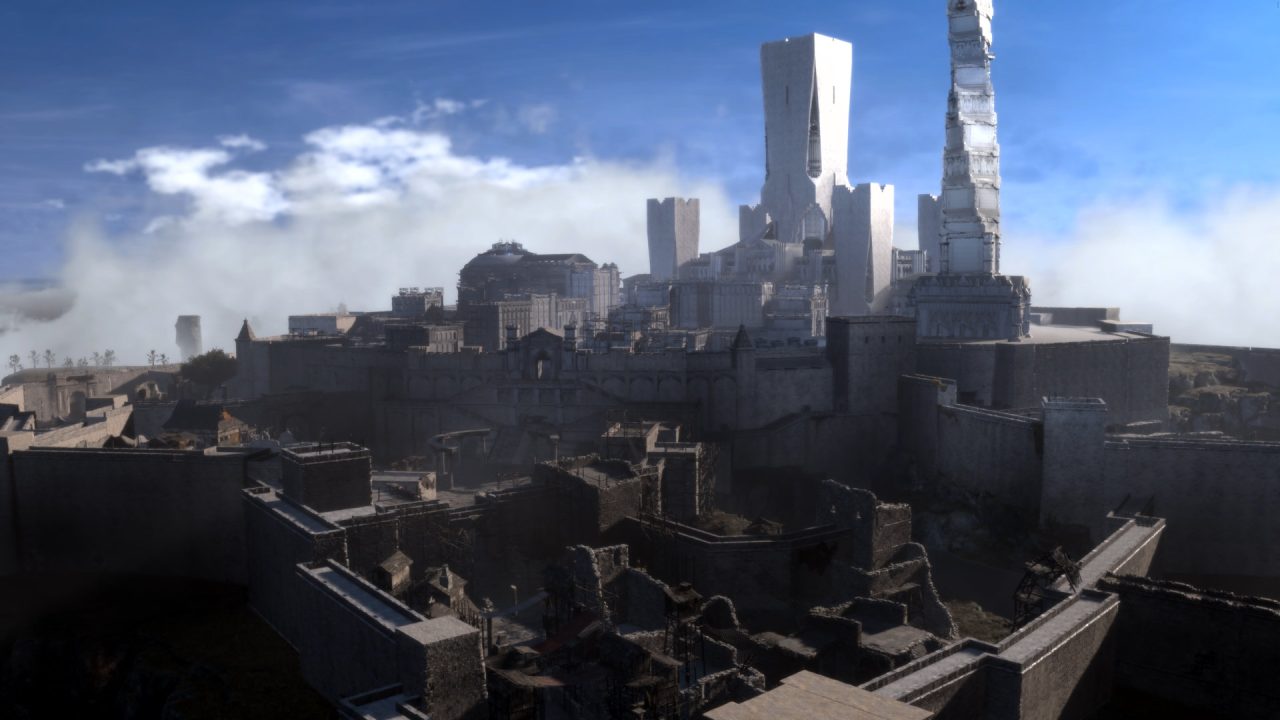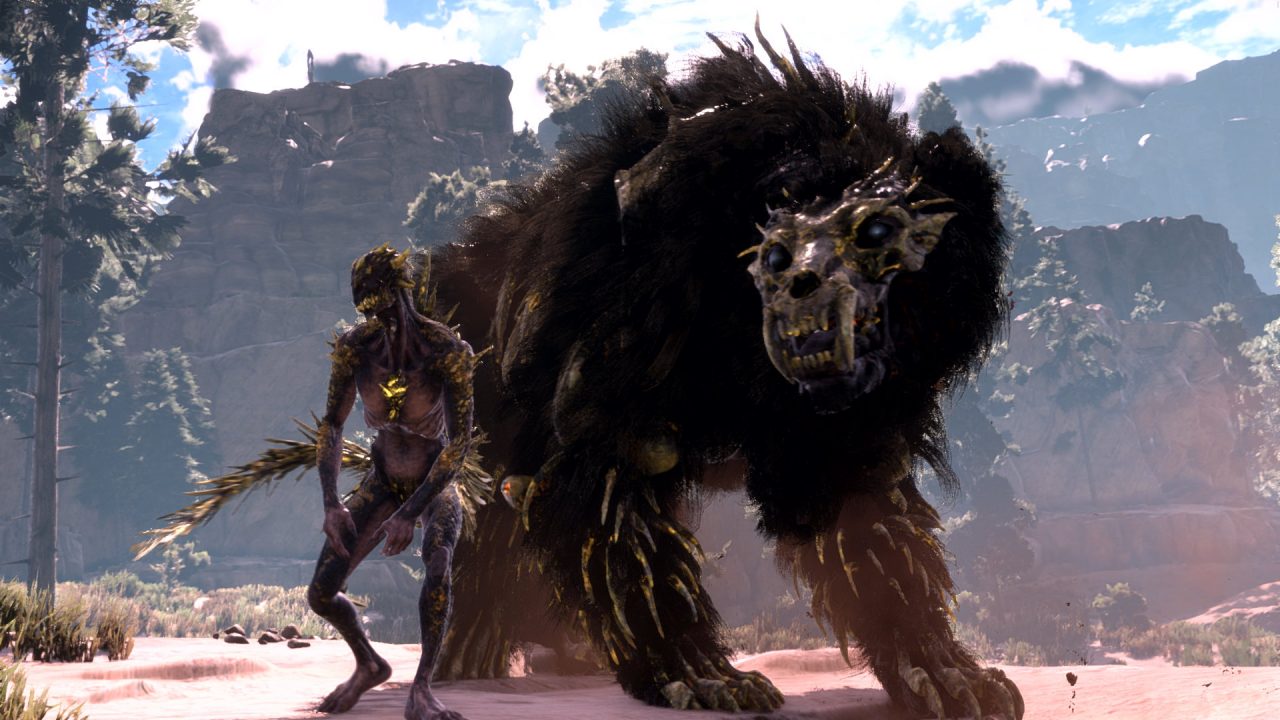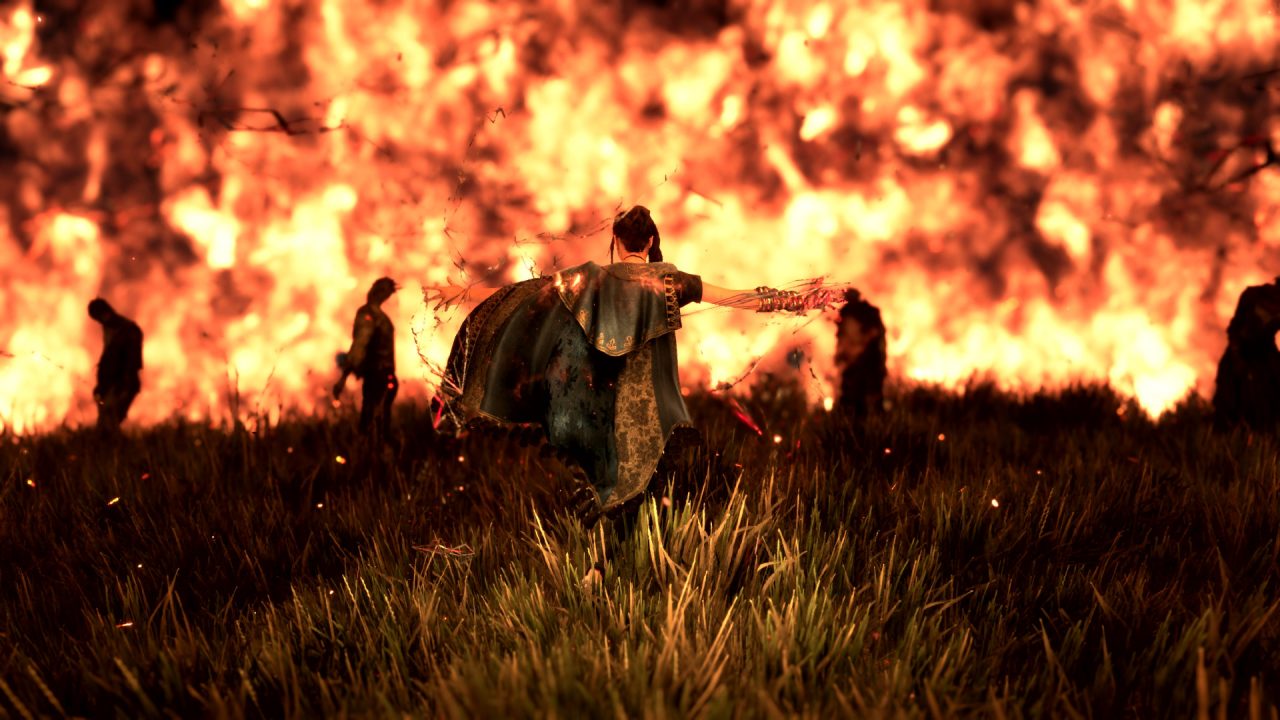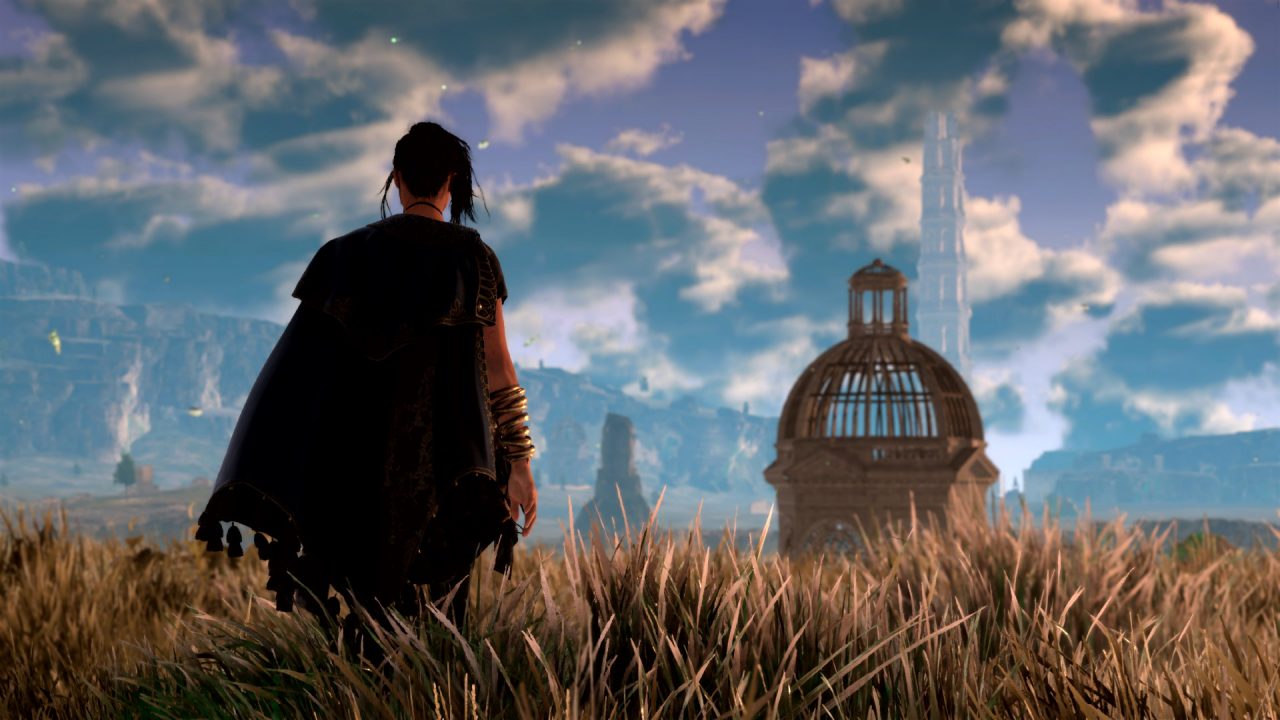There is no denying that Luminous Studios’ Final Fantasy XV was an enormous success for Square Enix. Yes, there is some divisive sentiment, but anyone would expect a successor without XV’s troubled development to generate widespread excitement. And yet, Forspoken’s marketing has struggled to find its footing and driven the online discourse in a surprisingly negative direction. Personally, the appeal has never gone away. A beautiful action RPG with an array of incredibly animated magical spells at my disposal, a diverse cast of characters, and breakneck open-world traversal? Sign me up. The chance it could ultimately be a mess makes it all the more enticing to review.
Forspoken begins not in the mythical lands of Athia but in a New York City courthouse. Enter twenty-year-old Alfre “Frey” Holland, our protagonist. She has a problem with authority, and sometimes, it brings her into conflict with the law. Luckily for her, a sympathetic judge lets her off with a warning as a birthday present. The birthday presents a local gang wants to give her are not so kind, leading to a series of events that leave Frey at rock bottom, only to find Cuff, a sentient piece of jewelry (or a vambrace as he calls himself), and a portal to another world. The portal pulls them both through and closes behind them. Frey is stranded.
On the other side lies Athia, a beautiful yet desolate world. Athia was once a peaceful place ruled by four powerful women sorcerers known as the Tantas, but a couple of decades before Frey’s arrival, a magical corruption that twisted the living into monsters spread across the land. Simultaneously, each Tanta was driven mad and either retreated from the world or began to terrorize their subjects. Survivors from all over Athia found themselves in the last bastion of humanity, Cipal.

Cipal serves as your base of operations for most of Forspoken. It is where you can undertake side quests (called Detours), trade items, and learn about the people of Athia and its history. Cipal is also a microcosm of the class issues that Frey experiences back in New York. The rich and the powerful live in the upper city; they get better food, better homes, and more safety. Everyone else lives in the run-down lower city. Yet, the people of Athia are surprisingly cheerful and compassionate, which clashes with Frey’s personal experiences and egocentric worldview.
When it comes time for Frey to use her newfound magical powers to face the Tantas, she does so not to help the people of Cipal, but for revenge and to find a way home, which sets her on a game-long character arc to become a better person. Frey is aided by the people of Cipal, who, despite Frey’s abrasive nature, do their best to make her feel welcome.
The interactions with other characters are fully voiced and range from heart-warming to painfully cheesy (early on, there are many arduous jokes where Frey uses earth slang that Athians don’t get) but is even occasionally genuinely funny. Still, even at their worst, I find myself fond of every character. Auden, the good-natured herbalist, is delightful in every moment she has on screen. Johedy, the gruff archivist, is always willing to point you in the right direction, even if she acts like she has no time for you. Pilo, the energetic carpenter, is annoyingly sincere and yet has charmed his way into being one of the beloved citizens of Cipal. Even the Tantas receive a surprising amount of depth despite having become mad forces of nature.
Once you step out of Cipal, the world turns hostile. Here be monsters — creepy, fascinating, and sometimes irritating monsters. I am a big fan of the monster designs in this game, as some of them look like they belong in a horror game (and evoke Annihilation, the movie or the Jeff VanderMeer novel it was based on). Though, I could do without Tanta Prav’s frustrating water archers, who always seem to come in large packs. Thankfully, Frey has a lot of ways to take revenge on those jerks.

Frey begins the game with her own earth-themed magic spells and eventually gains access to other elements. Each element has a skill tree on which you can spend mana (gained from leveling up or found glowing about the world) to buy new nodes. Spells belong to three main types, attack spells, support spells, and spells that boost your maneuverability in some way.
Each element has a basic attack or combo unique to that element — earth launches rocks, for example, and fire swings a flaming sword. You can then equip an attack spell that changes what happens when you charge that basic attack. For example, a water attack spell might cause a rain of arrows to fall on the targeted area. You can spam attack spells without worry. There is no MP to keep track of or magic charges to worry over.
Support spells, however, go on cooldown once used and range from buffs to yourself, debuffs to your enemies, elemental summons, or even powerful attacks. They are also beautifully and powerfully animated to make you feel like a real sorceress. Because there are so many support spells, turning on the setting in the options that automatically swaps to the next support spell is quite helpful. You can also quickly switch between your attack or support spells by holding R1 or L1 or your elemental magic sets by holding both L1 and R1. Combat comes into its own once you accrue an array of spells and utilize as many of them as you can. Blasting through your support spells across multiple elements can have a devastating effect on your enemies.
In practice, how much enjoyment the combat of Forspoken provides depends on which enemies you are facing. Bosses and mutants (dangerous unique monsters lurking in the wild) tend to be more engaging and push you to use your whole skill set. Plus, they are hard to lose track of despite a sometimes-exasperating camera system. On the contrary, packs of flying enemies can be incredibly frustrating to deal with as you clash with the camera to even see them, much less dodge their attacks, or launch your own.

Crafting also allows you to increase your combat effectiveness. Most chests you find out in the world give you materials you can use at crafting benches. Crafting lets you upgrade your equipment (cloaks and necklaces) and can become the majority of what determines your damage. So, while I am not a massive fan of this style of crafting system, I found watching my numbers go up enjoyable enough to keep doing it. However, the choices of passive abilities to add to your equipment are not particularly enticing. You can also use rarer crafting materials to paint your nails with runic symbols, granting further bonuses.
However, there is a bigger draw to Forspoken’s gameplay than its combat. I mentioned maneuverability-enhancing spells earlier, and the sheer directional mobility of Frey is where the game truly shines. One of the first abilities you obtain in Forspoken is Magic Parkour. Whenever you hold down the circle button, Frey begins to sprint incredibly fast, leaping over gaps, running up walls, and leap-frogging enemies. It is reminiscent of flowmotion from Kingdom Hearts III, but it works particularly well in a large open world that plays with verticality and 3D space so heavily. Other spells allow you to leap incredible distances, launch a grappling hook of fire magic or create a surfboard out of ice. Using these spells costs stamina, but the game is surprisingly generous with it, and you rarely have to slow down for long. There is a simple and primal joy in sprinting toward a wall, leaping a wide gap, grappling your way over said wall, landing on a lake, and surfing across it with your iceboard before diving into a group of unsuspecting enemies with an explosive AOE attack.
And what a world we are given to explore with Frey’s unparalleled mobility. While the image quality drops considerably at times, Athia is undeniably gorgeous, and its vistas may be unmatched in gaming. There is also an impressive array of locales: deserts, canyons, mountains, lakes, rivers, and meadows of flowers. Just being in Athia and taking a moment to look around might be worth the cost of the game alone. Unfortunately, thinking about the music, nothing comes to mind beyond that it felt appropriate. “Forgettable yet suitable” isn’t the worst crime music can commit, especially in an open world like this one.
Looking past the moment-to-moment gameplay, what does Forspoken’s open world offer? If you have ever played a checklist-style open-world game, then you know what to expect. The world is flooded with points of interest, from treasure chests to mutants to monuments that permanently increase your stats or allow you to make friends with the various cat familiars of the Tantas. Those cats, by the way, will come to hang out with you at Pilgrim’s Refuges, safe places to rest and craft, and are very much pet-able. More substantial points of interest come in the form of Locked Labyrinths and timed challenges. The former are mini-dungeons where you battle increasingly dangerous groups of foes before clashing with a unique boss. Your reward is usually a new cloak or necklace. The latter involves content like sprinting through a marked course as quickly as possible or defeating a boss within a time limit. If you enjoy clearing out points of interest, Forspoken is definitely for you, and there is much to occupy your time. If you are a player who focuses on the main story, then I think it is entirely viable to finish the game without doing much side content and in a startlingly short amount of time. My time with the (completed) main quest amounts to a well-paced 12-15 hours.

For some, this may be too short for a fully priced game, but the actual overarching structure of the game and its pacing are a pleasant surprise, so I am not going to complain. I won’t delve into spoilers, but suffice it to say: while the story itself is rarely surprising, how the game delivers it can be. The conclusions it reaches and the arcs the characters and the world takes are satisfying and rewarding. It may not be a storytelling masterpiece, but I am glad to have experienced it.
Forspoken is a far better and more compelling game than I had feared, but it also doesn’t reach the heights I dreamt of. There is a lot of fun to be had exploring Athia and the main quest keeps things interesting even when you get bored with the open-world checklist. But at the same time I can’t help but be disappointed with how safe Forspoken plays the open world, and I am unlikely to go back to clear out all of those rote points of interest. And I also can’t deny there are some eyebrow-raising moments as to how the writers chose to portray a black woman like Frey, despite personally liking her quite a bit when viewed through the lens of having finished the game. There is a lot of diversity in the cast too, in a way we don’t usually get from big-budget RPGs. I am not sure how many steps forward versus how many steps back Forspoken takes, but there are steps taken forward. In the end, I recommend Forspoken to anyone who loves Final Fantasy XV or Ubisoft-style open worlds and especially anyone who has a thing for character mobility. Yet, the game has a certain charm that I believe makes it worth giving a try to anyone.


